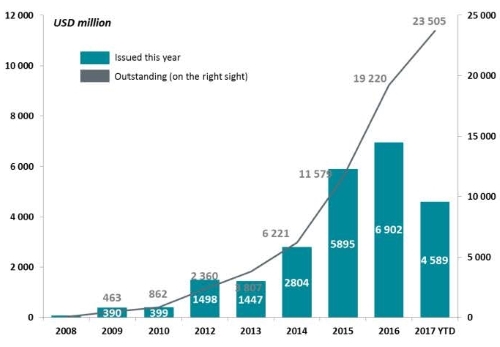
The International Capital Market Association (ICMA) unveiled Social Bond Principles yesterday (Wednesday), elevating guidelines introduced last year in a bid to promote growth in a move a leading investor said could benefit the overall ESG market.
The Social Bond Principles framework – unveiled at the third Green Bond Principles (GBP) AGM in Paris yesterday – is launched a year after Social Bond Guidelines were introduced and, when combined with ICMA’s Green Bond Principles, will henceforth constitute Sustainable Bond Guidelines for transactions incorporating the two sectors.
“This market isn’t one that is exploding, but if you look at the issues that have come out, you can see the guidelines we published this time last year seemed to help coalesce the market around this nascent standard,” said Nicholas Pfaff, senior director, ICMA. “What we’re trying to do with the Principles this year is to keep pushing in that direction.”
The new Social Bond Principles list as eligible projects with positive social outcomes areas such as: affordable housing; employment generation; food security; and socioeconomic advancement and empowerment.
“Social Projects are projects, activities and investments that directly aim to help address or mitigate a specific social issue and/or seek to achieve positive social outcomes especially, but not exclusively, for target population(s).”
Pfaff said the principles do not change the definition of social bonds as set out in the guidelines, but rather “elevate” the guidelines.
Manuel Lewin, head of responsible investment, Zurich Insurance, said the establishment of the Social Bond Principles shows that “green is not the only colour that matters to investors”, while Tanguy Claquin, head of sustainable banking at Crédit Agricole, told the GBP conference that the social bond market had reached a tipping point – both institutions are members of the Green Bond Principles executive committee.
In a panel discussion, Denise Odaro (pictured), head of investor relations at the International Finance Corporation (IFC), noted that $3.7bn (EUR3.2bn) of social bonds have been issued year-to-date, up from $2.8bn in full-year 2016.
“$3.7bn is even more than was issued in green bonds five years ago,” she added. “That should tell you how it is possible to grow this market to where green bonds are today.”
Social bond market growth

Source: market data, Crédit Agricole CIB, ICMA
IFC in March inaugurated a newly established social bond programme with a $500m three year social bond – the first US dollar benchmark social bond, according to Odaro. Proceeds from the bond are used to provide finance to companies that buy from smallholder farmers, provide utilities for low income households, and offer affordable health services, education, or housing to low income people.
IFC’s new programme was formed by a merger of two of its existing products, the Banking on Women Bond Program and the Inclusive Business Bond Program, through which IFC had earlier issued multiple smaller bonds.
“Thinking internally and based on what we had been hearing from investors, who are obviously seeking more ESG products, we decided to merge these programmes to gain operational efficiency and the ability to launch larger and more frequent transactions,” said Odaro. “In summary, I would say the two reasons we have branched into this market are one, in response to investor demand, and two, to highlight the work that we do.”
Also speaking on the panel, Cathy DiSalvo, investment officer at CalSTRS (the California State Teachers’ Retirement System), said the IFC benchmark debut was the first social bond that her organisation participated in.
“We’re very new to the market, but we’re excited to be a part of it,” she said. “We integrate ESG into our investments, and buying green and social bonds helps to reach our goals.
“To be honest, without the Social Bond Principles, we probably would not invest in social bonds just yet, as they are very new,” she added. “But the principles lay it all out, just like the Green Bond Principles, and make it a lot easier for investors to know what to look for and for issuers to know what investors want.”
DiSalvo suggested that the growth of the social bond market could be beneficial for the wider ESG market, potentially increasing liquidity in the green bond market.
Photo credit: ICMA



